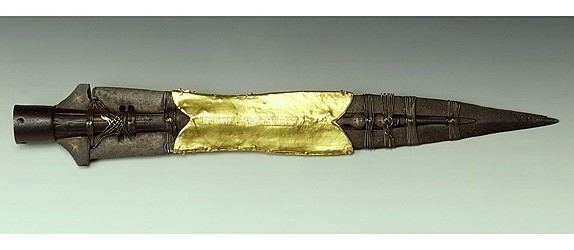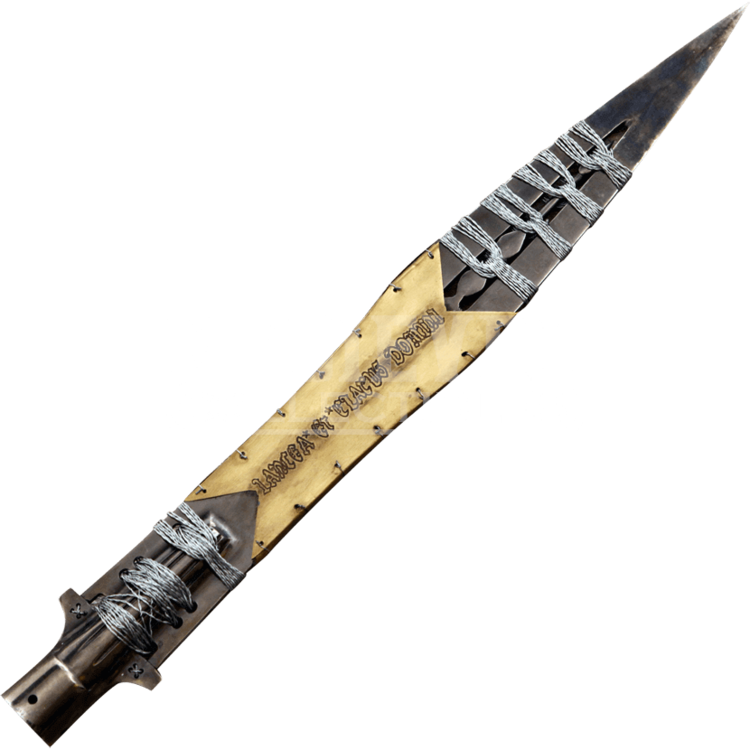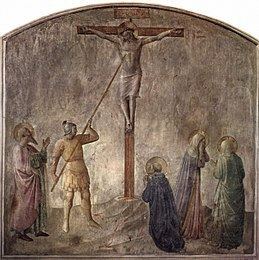 | ||
The Holy Lance, also known as the Holy Spear, the Spear of Destiny or the Lance of Longinus, according to the Gospel of John, is the lance that pierced the side of Jesus as he hung on the cross.
Contents
- Liturgical re enactments
- Longinus
- Relics
- Rome
- Vienna
- Echmiadzin
- Antioch
- Other lances
- Richard Wagner
- Trevor Ravenscroft
- In popular culture
- References

Liturgical re-enactments

The phenomenon of blood and water was considered a miracle by Origen. Catholics, while accepting the biological reality of blood and water as emanating from the pierced heart and body cavity of Christ, also acknowledge the allegorical interpretation: it represents one of the main key teachings/mysteries of the Church, and one of the main themes of the Gospel of Matthew, which is the homoousian interpretation adopted by the First Council of Nicaea, that "Jesus Christ was both true God and true man." The blood symbolizes his humanity, the water his divinity. A ceremonial remembrance of this is done when a Catholic priest says Mass: The priest pours a small amount of water into the wine before the consecration, an act which acknowledges Christ's humanity and divinity and recalls the issuance of blood and water from Christ's side on the cross. Saint Faustina Kowalska, a Polish nun whose advocacy and writings led to the establishment of the Divine Mercy devotion, also acknowledged the miraculous nature of the blood and water, explaining that the blood is a symbol of the divine mercy of Christ, while the water is a symbol of His divine compassion and of baptismal waters.

In most variants of the Orthodox Divine Liturgy, the priest lances the host (prosphoron) with a liturgical spear before it is divided in honor of the Trinity, the Theotokos (Virgin Mary), and various other remembrances. The deacon recites the relevant passage from the Gospel of John, along with sections of the Acts of the Apostles dealing with commemoration of the saints. Most of these pieces, set aside, become the antidoron to be distributed after the liturgy, a relic of the ancient agape of apostolic times, considered to be blessed but not consecrated or sanctified in the Western understanding. The main piece becomes The Lamb, the host that is consecrated on the altar and distributed to the faithful for Holy Communion.
Longinus

The name of the soldier who pierced Christ's side with a lonchē is not given in the Gospel of John, but in the oldest known references to the legend, the apocryphal Gospel of Nicodemus appended to late manuscripts of the 4th century Acts of Pilate, the soldier is identified as a centurion and called Longinus (making the spear's Latin name Lancea Longini).

A form of the name Longinus occurs on a miniature in the Rabula Gospels (conserved in the Laurentian Library, Florence), which was illuminated by one Rabulas in the year 586. In the miniature, the name LOGINOS (ΛΟΓΙΝΟϹ) is written in Greek characters above the head of the soldier who is thrusting his lance into Christ's side. This is one of the earliest records of the name, if the inscription is not a later addition.
Relics

There have been three or four major relics that are claimed to be the Holy Lance or parts of it.
Rome
The Holy Lance in Rome is preserved beneath the dome of Saint Peter's Basilica, although the Catholic Church makes no claim as to its authenticity. The first historical reference to the lance was made by the pilgrim Antoninus of Piacenza (AD 570) in his descriptions of the holy places of Jerusalem, writing that he saw in the Basilica of Mount Zion "the crown of thorns with which Our Lord was crowned and the lance with which He was struck in the side". A mention of the lance occurs in the so-called Breviarius at the Church of the Holy Sepulchre. The presence in Jerusalem of the relic is attested by Cassiodorus (c. 485–585) as well as by Gregory of Tours (c. 538–594), who had not actually been to Jerusalem.
In 615, Jerusalem and its relics were captured by the Persian forces of King Khosrau II (Chosroes II). According to the Chronicon Paschale, the point of the lance, which had been broken off, was given in the same year to Nicetas, who took it to Constantinople and deposited it in the church of Hagia Sophia, and later to the Church of the Virgin of the Pharos. This point of the lance, which was now set in an icon, was acquired by the Latin Emperor, Baldwin II of Constantinople, who later sold it to Louis IX of France. The point of the lance was then enshrined with the crown of thorns in the Sainte Chapelle in Paris. During the French Revolution these relics were removed to the Bibliothèque Nationale but the point subsequently disappeared.
As for the larger portion of the lance, Arculpus claimed he saw it at the Church of the Holy Sepulchre around 670 in Jerusalem, but there is otherwise no mention of it after the sack in 615. Some claim that the larger relic had been conveyed to Constantinople in the 8th century, possibly at the same time as the Crown of Thorns. At any rate, its presence at Constantinople seems to be clearly attested by various pilgrims, particularly Russians, and, though it was deposited in various churches in succession, it seems possible to trace it and distinguish it from the relic of the point. Sir John Mandeville declared in 1357 that he had seen the blade of the Holy Lance both at Paris and at Constantinople, and that the latter was a much larger relic than the former; it is worth adding that Mandeville is not generally regarded as one of the Middle Ages' most reliable witnesses, and his supposed travels are usually treated as an eclectic amalgam of myths, legends and other fictions. "The lance which pierced Our Lord's side" was among the relics at Constantinople shown in the 1430s to Pedro Tafur, who added "God grant that in the overthrow of the Greeks they have not fallen into the hands of the enemies of the Faith, for they will have been ill-treated and handled with little reverence."
Whatever the Constantinople relic was, it did fall into the hands of the Turks, and in 1492, under circumstances minutely described in Pastor's History of the Popes, the Sultan Bayezid II sent it to Pope Innocent VIII to encourage the pope to continue to keep his brother and rival Zizim (Cem Sultan) prisoner. At this time great doubts as to its authenticity were felt at Rome, as Johann Burchard records, because of the presence of other rival lances in Paris (the point that had been separated from the lance), Nuremberg (see Holy Lance in Vienna below), and Armenia (see Holy Lance in Echmiadzin below). In the mid-18th century Pope Benedict XIV states that he obtained from Paris an exact drawing of the point of the lance, and that in comparing it with the larger relic in St. Peter's he was satisfied that the two had originally formed one blade. This relic has never since left Rome, and its resting place is at Saint Peter's.
Vienna
The Holy Lance in Vienna is displayed in the Imperial Treasury or Weltliche Schatzkammer (lit. Secular Treasure Room) at the Hofburg Palace in Vienna, Austria. In the tenth century, the Holy Roman Emperors came into possession of the lance, according to sources from the time of Otto I (912–973). In 1000, Otto III gave Boleslaw I of Poland a replica of the Holy Lance at the Congress of Gniezno. In 1084, Henry IV had a silver band with the inscription "Nail of Our Lord" added to it. This was based on the belief that this was the lance of Constantine the Great which enshrined a nail used for the Crucifixion.
In 1273, the Holy Lance was first used in a coronation ceremony. Around 1350, Charles IV had a golden sleeve put over the silver one, inscribed Lancea et clavus Domini (Lance and nail of the Lord). In 1424, Sigismund had a collection of relics, including the lance, moved from his capital in Prague to his birthplace, Nuremberg, and decreed them to be kept there forever. This collection was called the Imperial Regalia (Reichskleinodien).
When the French Revolutionary army approached Nuremberg in the spring of 1796 the city councilors decided to remove the Reichskleinodien to Vienna for safe keeping. The collection was entrusted to a Baron von Hügel, who promised to return the objects as soon as peace had been restored and the safety of the collection assured. However, the Holy Roman Empire was disbanded in 1806 and the Reichskleinodien remained in the keeping of the Habsburgs. When the city councilors asked for the Reichskleinodien back, they were refused. As part of the imperial regalia it was kept in the Imperial Treasury and was known as the lance of Saint Maurice.
During the Anschluss, when Austria was annexed to Germany, the Reichskleinodien were returned to Nuremberg and afterwards hidden. They were found by invading U.S. troops and returned to Austria by American General George S. Patton after World War II.
Robert Feather, an English metallurgist and technical engineering writer, tested the lance for a documentary in January 2003. He was given unprecedented permission not only to examine the lance in a laboratory environment, but was allowed to remove the delicate bands of gold and silver that hold it together. In the opinion of Feather and other academic experts, the likeliest date of the spearhead is the 7th century A.D. – only slightly earlier than the Museum's own estimate. Feather stated in the same documentary that an iron pin – long claimed to be a nail from the crucifixion, hammered into the blade and set off by tiny brass crosses – is "consistent" in length and shape with a 1st-century A.D. Roman nail.
Echmiadzin
A Holy Lance is conserved in Vagharshapat (previously known as Echmiadzin), the religious capital of Armenia. It was previously held in the monastery of Geghard. The first source that mentions it is a text Holy Relics of Our Lord Jesus Christ, in a thirteenth-century Armenian manuscript. According to this text, the spear which pierced Jesus was to have been brought to Armenia by the Apostle Thaddeus. The manuscript does not specify precisely where it was kept, but the Holy Lance gives a description that exactly matches the lance, the monastery gate, since the thirteenth century precisely, the name of Geghardavank (Monastery of the Holy Lance).
In 1655, the French traveler Jean-Baptiste Tavernier was the first Westerner to see this relic in Armenia. In 1805, the Russians captured the monastery and the relic was moved to Tchitchanov Geghard, Tbilisi, Georgia. It was later returned to Armenia at Echmiadzin, where it is always visible in the museum Manoogian, enshrined in a 17th-century reliquary.
Antioch
During the June 1098 Siege of Antioch, a poor monk named Peter Bartholomew reported that he had a vision in which St. Andrew told him that the Holy Lance was buried in the Church of St. Peter in Antioch. After much digging in the cathedral, Peter apparently discovered a lance. Despite the doubts of many, including the papal legate Adhemar of Le Puy, the discovery of the Holy Lance of Antioch inspired the starving Crusaders to break the siege and secure the city.
Other lances
Another lance has been preserved at Kraków, Poland, since at least the 13th century. However, German records indicate that it was a copy of the Vienna lance. Emperor Henry II had it made with a small sliver of the original lance. Another copy was given to the Hungarian king at the same time.
The story told by William of Malmesbury of the giving of the Holy Lance to King Athelstan of England by Hugh Capet seems to be due to a misconception.
Richard Wagner
In his opera Parsifal, Richard Wagner identifies the Holy Spear with two items that appear in Wolfram von Eschenbach's medieval poem Parzival, a bleeding spear in the Castle of the Grail and the spear that has wounded the Fisher King. The opera's plot concerns the consequences of the spear's loss by the Knights of the Grail and its recovery by Parsifal. Having decided that the blood on the Spear was that of the wounded Saviour – Jesus is never named in the opera – Wagner has the blood manifest itself in the Grail rather than on the spearhead.
Trevor Ravenscroft
The "Spear of Destiny" is a name given to the Holy Lance in various accounts that attribute mystical powers to it. Many of these have originated in recent times, and several popular New Age and conspiracy theory books have popularized the legend of the Spear.
Trevor Ravenscroft's 1973 book, The Spear of Destiny (as well as a later book, The Mark of the Beast), claims that Adolf Hitler started World War II in order to capture the spear, with which he was obsessed. At the end of the war the spear came into the hands of US General George S. Patton. According to legend, losing the spear would result in death, and that was fulfilled when Hitler committed suicide and Patton died in a car accident in an army camp.
Ravenscroft repeatedly attempted to define the mysterious "powers" that the legend says the spear serves. He found it to be a hostile and evil spirit, which he sometimes referred to as the Antichrist, though that is open to interpretation. He never actually referred to the spear as spiritually controlled, but rather as intertwined with all of mankind's ambitions.
In popular culture
A search for the lance is depicted in the 2004 adventure fantasy film The Librarian: Quest for the Spear, which incorporates references to Hitler's supposed obsession with the relic.
The legend of the lance is told by a character in the 2004 Japanese film Longinus.
The 1995 anime Neon Genesis Evangelion takes inspiration from the original Holy Lance and incorporates its own interpretation of the Lance of Longinus into its narrative. Within the series, the lance is colored bright red with a spiral-like handle and a two pronged tip. The lance is normally depicted as being impaled within the crucified body of Lilith, a crucial character within the series, as an allusion to the crucifixion of Jesus. Canonically, the lance functions as a fail-safe which suppresses the abilities of Adam or Lilith, who both possess a Lance of Longinus, in the event in which both entities land on a single planet, compromising the intentions of the First Ancestral Race.
The Spear of Destiny plays a part in the second season of time-travelling superhero series Legends of Tomorrow, where series antagonists the Legion of Doom intend to find the Spear to rewrite their future destinies and final defeats.
The Spear of Destiny is a key plot element of the film Constantine, where agents of Mammon, the son of the Devil, currently allied with the archangel Gabriel, intend to use the spear to help him be born into the real world to trigger his own apocalypse, only to be defeated when Constantine sacrifices himself to alert Lucifer to his son's schemes.
In DC Comics, the Spear was used by Hitler to summon actual mythical Valkyries to fight on Germany's behalf, and then later used to cast a spell that would render any Allied superhero under Nazi control, if they entered into territory held by the Axis. Hitler attempted to use the Spear at war's end and call down the end of the world, but the sacrifice of the future Justice Society of America prevented this. The Spear survived the war's end, and was once used to try and bring down The Spectre, when that entity was out of control. Superman was given the Spear to accomplish this, but it had the side effect of giving him the personality of the Spear's prior wielder, being Hitler himself. The menace this posed roused the Spectre from his rage, and he freed Superman from the Spear's influence.
The Spear of Destiny is the title of an additional episode to the Wolfenstein 3D first-person shooter video game. The game features a story line concerning Nazi mysticism and occult practices and the main protagonists quest to recover the spear from the Nazi's.
